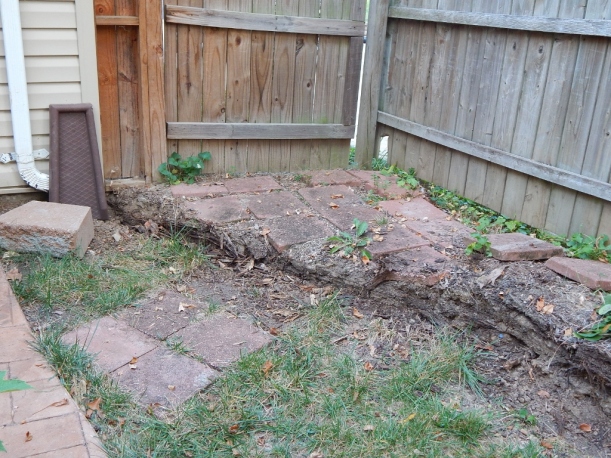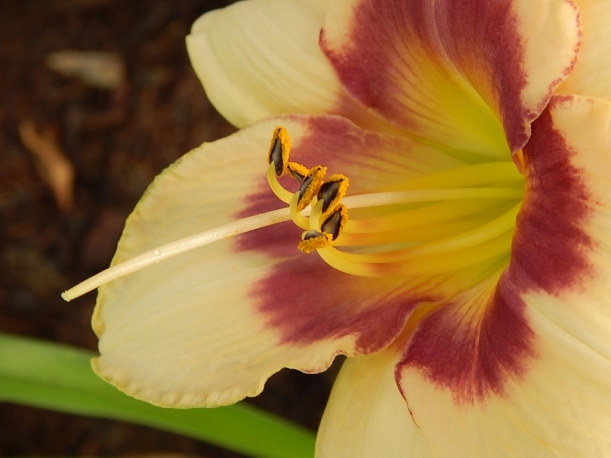Tag Archives: caladium
Ah Yes Moments in 2015
 If you’re like me, it’s easy to look in the rear view mirror and lament what went wrong during the previous season and think about all the “could ofs,” “should ofs” and “only ifs” as I plan for the next.
If you’re like me, it’s easy to look in the rear view mirror and lament what went wrong during the previous season and think about all the “could ofs,” “should ofs” and “only ifs” as I plan for the next.
Last year was not the best year for my back yard garden. The tremendous amount of rain we had in June took a toll on the way the plants performed, and it seemed like there was never enough time to accomplish what needed to be done. But, there were plenty of highlights to year 4 in my gardens. Here are few:
1. Improving the Entrance into the Yard. Visitors who came through the gate in 2014 were met with a raised bed supported by rotting railroad ties whose 5-inch nail spikes stuck out. The step down into the yard was deep, making it awkward and potentially dangerous. I said goodbye to the ties and installed interlocking stone that coordinates with the stamped concrete patio. An added step provides a more natural distance down into the yard.
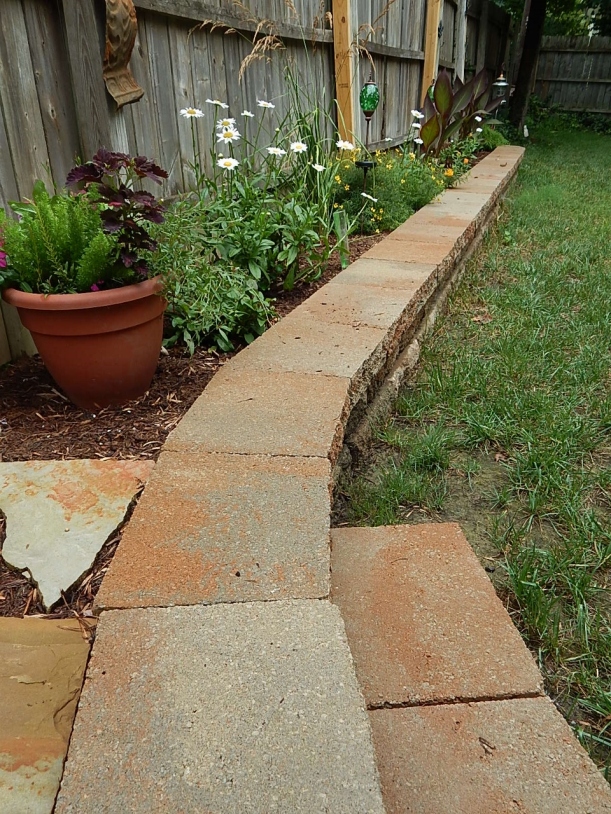
The addition of a step off of the raised area, makes stepping into the yard easier. The shasta daisies are transplants from a friend, as are the cannas.
2. Attending the Garden Bloggers Fling in Toronto. Okay, this is technically not in my garden, but I’ll extol the virtues of expanding your network to anyone who enjoys gardening. First, who doesn’t like a garden tour? The Fling was a 3-day-plus extravaganza of garden tours. This experience allowed me to learn first-hand from other gardeners–hobbyists to the pros–what they are doing in their gardens and public spaces. It was an outstanding way to expand my thoughts on gardening and meet many of the people behind the blogs I so enjoy. The Fling has me thinking more seriously about natural resources conservation, starting a vegetable garden, composting and the joys of connecting with those who share a common passion.
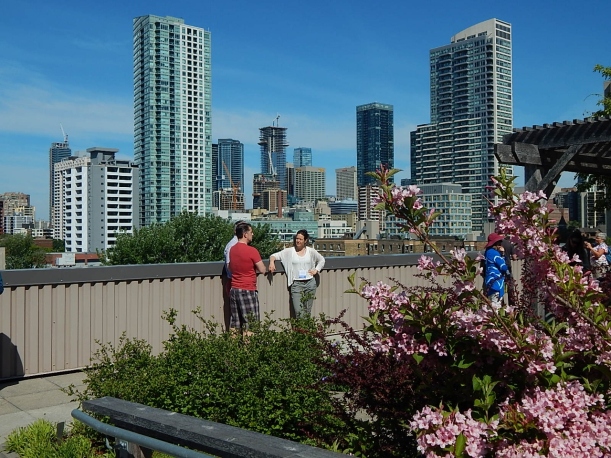
A rooftop garden overlooking the Toronto city skyline. The Garden Fling provided multiple venues to learn about gardening, sustainability, conservation and plant selection.
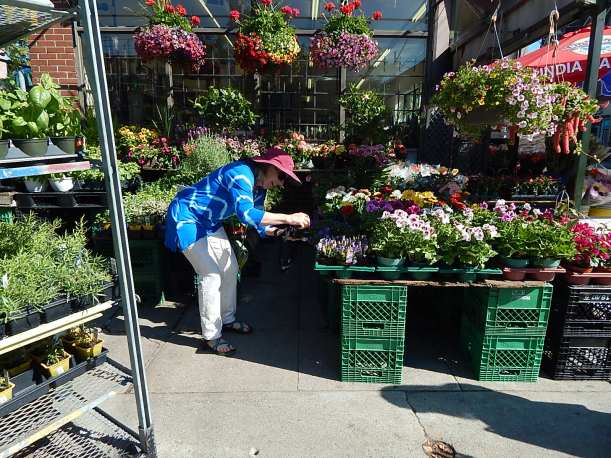
Claire Jones, author of the Garden Diaries blog, takes time to appreciate the offerings at a city nursery in Toronto.
3. Installing a new bed along the south fence. Outside of raising children, nothing teaches patience like gardening. I may be planning and planting for four-season beauty, but each garden season (spring/summer/fall) is just one cycle and it took me several cycles to finally get to the south fence. I enjoyed sitting on the patio looking at this lovely, lovely shade garden.
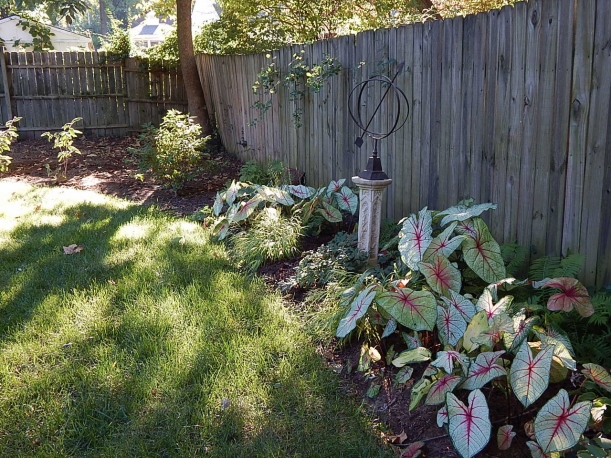
The caladium take center stage in the bed in September. The honeysuckle trailing over the fence from my neighbor’s yard was a welcome guest.

Freshly mulched, the south fence bed in June. Japanese forest grass, heuchera various fern, hosta, creeping Jenny, solomon seal and astilbe provided lots to look at all season.
4. Edging the Beds. What a difference a seemingly small task makes in giving a garden bed a finished look. I considered installing metal edging, but instead opted for the back labor (someone else’s, as I hired this job out) to cut a nice edge around my main garden beds.

3. Plant division. Want to save a little money? Get more of a plant you just love, love, love? Fill in a space in the garden bed? Share with a good friend? Improve your garden design and color balance? Two words: Plant division.
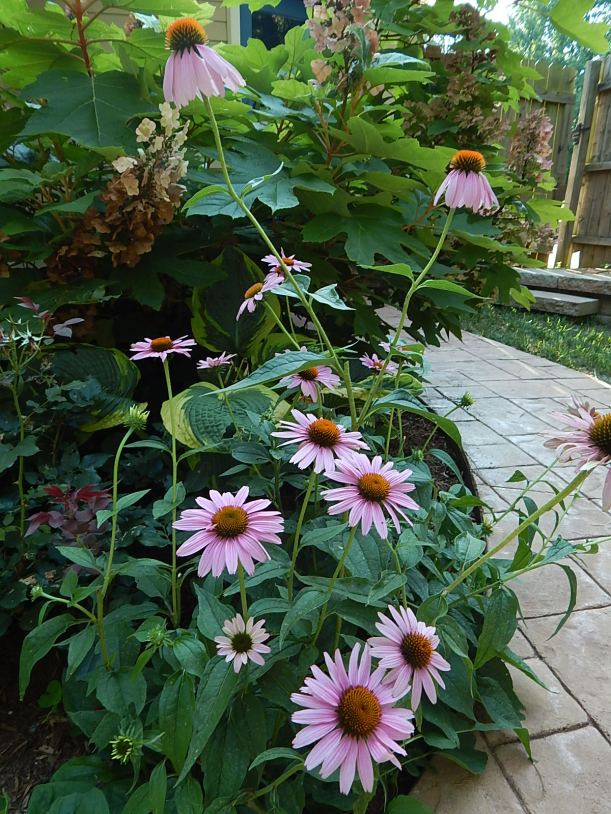
First purchased from the Webster Groves Women’s Garden Club plant sale, these purple coneflower have been divided and added throughout the gardens. Self-seeders, they quickly and easily multiply.
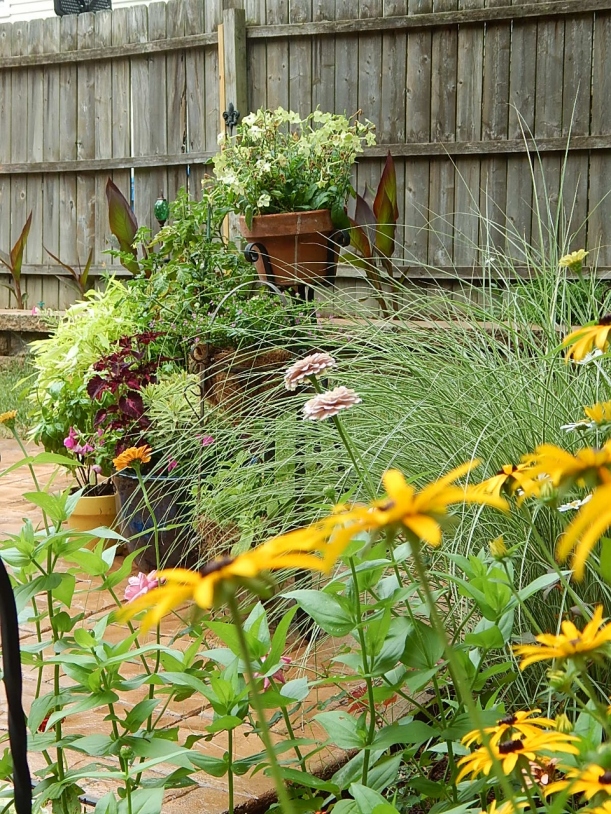
The black-eyed Susans in the foreground have three homes in my yard. Profusive in Zone 6, I gladly divide them to share with friends.
Upside/Downside in the Garden This Week
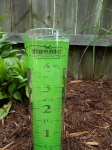 I don’t need my new rain gauge to tell me we’ve had a lot of rain in St. Louis. The “tap” has been running since last Sunday, and this morning the rain gauge was filled to the brim, indicating we’ve had nearly six inches of rain. Needless to say, all this moisture has had upsides and some downsides. Without further adieu, here’s a quick recap of my Arch City garden:
I don’t need my new rain gauge to tell me we’ve had a lot of rain in St. Louis. The “tap” has been running since last Sunday, and this morning the rain gauge was filled to the brim, indicating we’ve had nearly six inches of rain. Needless to say, all this moisture has had upsides and some downsides. Without further adieu, here’s a quick recap of my Arch City garden:
I was gone for the first part of the week so the upside is I did not need to water; the downside is ponding in parts of the yard, plants soaked to the bone and weeds, weeds, weeds. It finally stopped raining today and I spent an enjoyable few hours this morning tidying things up. You can translate that to mean trimming back spent blooms from the penstemon, lilies, lady’s mantle and roses, as well as the annuals. I have noticed lots of spots and white stuff on some of the plants, including the penstemon, echinacea and rudbeckia, so I cut back quite a bit. The roses have been food for some insect and now are displaying lacy leaves. Not a good sign.
By noon the sun was out in full force, the humidity unbearable and yours truly headed back inside.
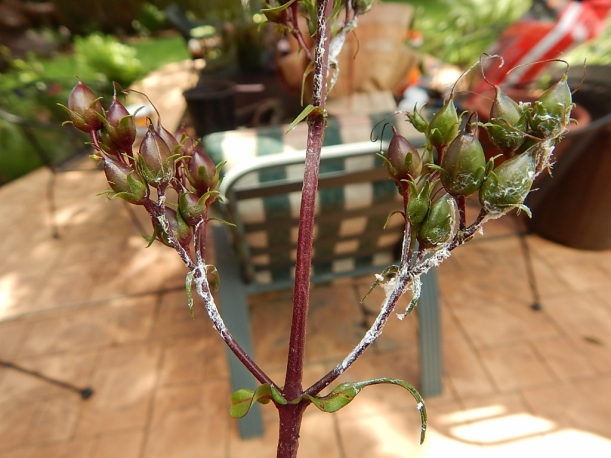
 There are some bright spots to the garden as well. The daylilies my neighbor generously gave me last summer are starting to bloom and they are lovely, although the liriope nearby have been heartily munched upon (I suspect rabbits) and the more than one dozen tomatoes on my patio plant are g-o-n-e. That would be squirrels. In fact, they left half-eaten tomatoes scattered upon the lawn. Ingrates.
There are some bright spots to the garden as well. The daylilies my neighbor generously gave me last summer are starting to bloom and they are lovely, although the liriope nearby have been heartily munched upon (I suspect rabbits) and the more than one dozen tomatoes on my patio plant are g-o-n-e. That would be squirrels. In fact, they left half-eaten tomatoes scattered upon the lawn. Ingrates.
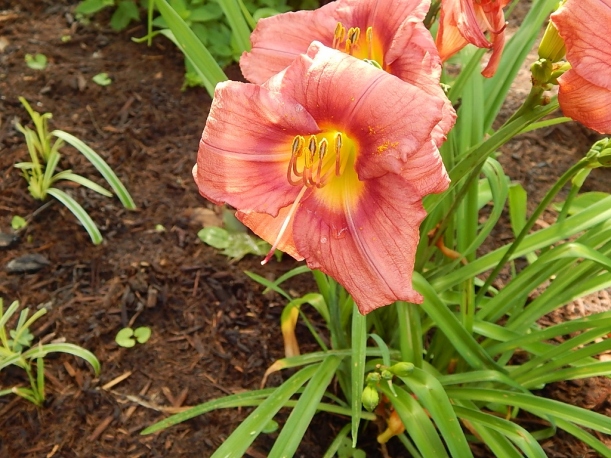
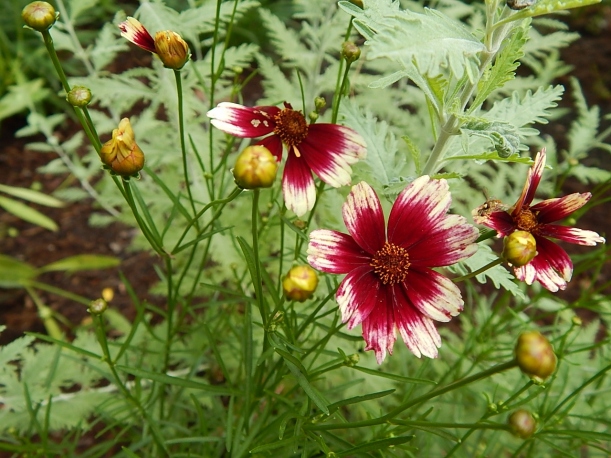 The “Berry Chiffon” tickseed I planted before I left for the Fling has begun to bloom and is quite showy with deep pink petals whose tips appear to be painted white. Yet some of the liatris nearby has been trampled just as it is beginning to bloom. It is now cut back and in a vase in the family room.
The “Berry Chiffon” tickseed I planted before I left for the Fling has begun to bloom and is quite showy with deep pink petals whose tips appear to be painted white. Yet some of the liatris nearby has been trampled just as it is beginning to bloom. It is now cut back and in a vase in the family room.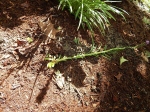
The astilbe in the newly installed south bed were stunning and I could not be happier with the plants in this shady part of the yard–fern, Japanese forest grass, hosta, Solomon seal, coral bells. As the raspberry plumes on the astilbe begin to fade, the caladium are starting to emerge, although some critter seems to have had a nibble or two on them as well. Rabbits? I suspect so but am not sure. I’ve never grown caladium in the ground. Readers, any tips for critter control?
The true test of the garden will be when the heat really kicks up. I guess that test will be tomorrow, as we expect temperatures in the mid 90s.
4 Annuals I am Obsessed With
A benefit of surviving a hot, humid St. Louis summer is that sub-tropicals perform well here as annuals. My list below includes annuals I’m obsessed with that are common in the south, but also pack a punch here in the Midwest. Or maybe I’m obsessed with these selections because they are a throw-back to my early 20s, when I lived in Houston, TX, where I was able to admire these plants day in and day out. Either way, these plants bring up the garden energy a notch and provide a leave me with sense of joy long after their beauty has faded. Most on the list I plant each and every year; while Canna has yet to join the backyard annuals.
What annuals accent your garden?
Embed from Getty Images
Canna. No, St. Louis is not the tropics, although a sweltering July or August day will give zones 8-10 a good run for their money. I do not live in the right zone for this plant, so it is classified as an annual here, but, yes, I’ve got to have this plant. I promise to shelter it from harsh winds and give it the full sun it requires and I am confident this tall, handsome plant will return the favor with gorgeous foliage that climbs the length of its 8-ft height and an unfurling of vibrant, ruffled flowers.
Embed from Getty Images
Caladium. Arching gracefully above the other mix of annuals in my window boxes on the front of my house, caladiums provide a little bit of that extra curb appeal I’m looking for every summer. And they give me the height I am looking for…not too tall, but just enough to draw attention. Their variegated white/green/pink foliage provide a nice pop of color in the shade, and I adore their arrowhead shape. So pretty, you might forget they’re not a flower.
Mexican heather (cuphea hissopifolia). Some like it hot and this baby really performs when the sun beats down…as long as it receives a restorative drink of water each day. Looking for a plant that seems to be in constant bloom? Mexican heather is the perfect choice, as it always has small purple blooms among its glossy green leaves. I have incorporated this annual into my potting scheme for several years now and have never looked back. Typically I fill a pot with a variety of annuals for visual interest, but not with this one. She gets a pot all to herself.
Embed from Getty Images
Nicotiana (nicotiana sylvestris). Known as flowering tobacco (for the shape of its leaves, I suspect), I am a big fan of this guy. The bright, star-shaped blooms on this annual really know how to show off. And when daylight gives way to evening, nicotiana lets of a fragrant scent that’s sure to make you slow down and take notice. I have typically planted this in pots but this year I intend to give it a go in the garden bed to accent “Spruce Springsteen,” the name we have affectionately given the dwarf Colorado blue spruce that I planted a year ago. I gave Spruce lots of space to accommodate its girth, which won’t happen for a few more years. Nicotiana will be a nice way to fill up the mulch bed.









